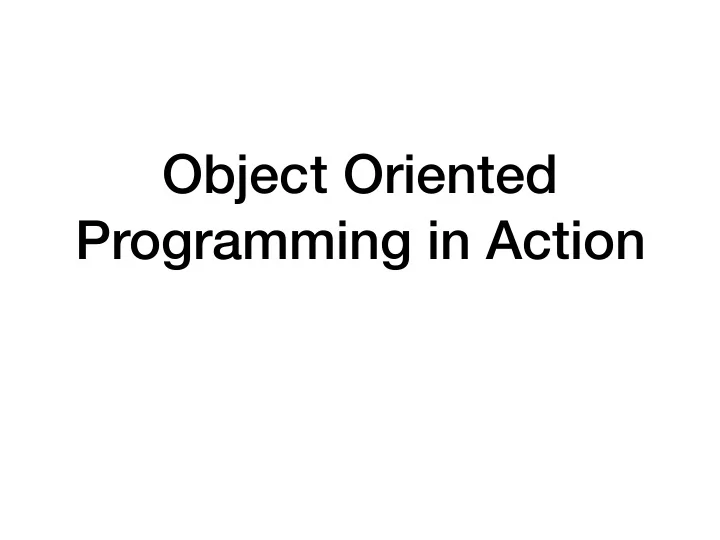

Object Oriented Programming in Action
Object Oriented Analysis and Design • Find and define the objects • Organize the objects • Describe how the objects interact with one another • Define the external behavior of the objects • Define the internal behavior of the objects
Robots Game • Robots Game • Turn-based game used to teach the navigation keys of text editor vi • Invented for Unix • Still available as a Linux console game
Game Description • The player controls an avatar in a two-dimensional playing field • The player can move left and right, upwards and downwards and also move diagonally • A number of robots try to kill the player by reaching the same space on which the avatar is • Robots only move up and down, left and right, but not diagonally • If robots collide with each other, they die and leave behind a heap • If the avatar or a robot moves into a heap, they also die • The player can use a teleportation device that places the player in a random location in the field, possibly next to a robot or a heap, but not in a heap. • If all robots are dead, then the player has won the level and advances to a higher level with more robots
Game Design • Designing something complex is very di ffi cult • Can use design patterns • We are going to use the Model-View-Controller pattern • Model: The data and its business logic • View: The window on the screen • Controller: The glue between the two
Game Design • Model is independent of view and controller • You can work simply in the model to implement the business logic • Regardless of visual presentation and user interface
Game Design uses manipulates Controller Model returns data User renders updates View Controller • MVC is popular in web development • Used in many frameworks such as Django, web2py, Pyramid, ...
Game Design • Model - The logic of the application • Model has a state and methods for changing the state such as a player move • We should be able to change the controller and the view without changing the logic
Game Design • View - the display of the model • View receives data from the model through the controller • Responsible for visualization • Does not contain complex logic • This belongs in the controller and the model
Game Design • Controller - Glue between Model and View • Controller receives data from user requests and sends it to other parts of the system • Controller also receives data from the model and passes them on to the View
Game Design • Design recommendations: • Smart Models • Thin controllers • Dumb viewers
Game Design • Modeling the Model • Look through the description • Identify substantives and verbs • We have actors: • Avatar • Robots • Heap • We have the playground
Game Design • Create cards with the name of the object • Add notes on what they need to interact with the other parts. Avatar Heap Robot Playground Location Location Location Collision Collision Collision Grid Move Move contains robots, heaps, avatars
Game Design • Because we use location so often, we pull it into its own class. • We also need to figure out how the View and the Control are interacting with the model. • View needs to get coordinates for all entities in order to display them • Control needs to steer the avatar. • This is done with a direction • which we make into another class.
Game Design Avatar Heap Robot has a has a has a moves collides moves collides collides Location Direction __equal__ change
Game Design • Design of View • View depends on the underlying architecture • We are going to rebuild the game using Tkinter graphics soon • Currently, the view is based on an Idle shell ASCII art • Need to move geometry between Controller and View • Need to get things to display from controller • Need to move decisions from View to Controller
Game Design • Design of Control • Needs to start the game: Play • Needs to transmit the model data to view • Needs to obtain User input
Game Design Command View Model run_game() clear_screen() avatar draw_screen() robots heaps update() Location Direction x move_towards() y == generate_ran ‐ dom_locality() update_loca ‐ tion() get() Geometry width height
Game Design • Write all the substantives on little cards • You get a design like this one • Now you go and expand all of the cards with methods • The design will change as you go through it
Game Design View Controller Model Game Display DisplayList Robot Geometry Robot Robot Robot Robot Robot Play User Heap Interface Heap Heap User Input Heap Direction Avatar
Implementation • Now it is time to start implementing • During implementation, design issues can emerge and force a redesign •
Software Engineering Errors • All implementations and designs will contain errors • Design errors are easiest to fix during design • Implementation errors are easiest to fix during implementation • Need a thorough testing phase
Testing • Need something better than just playing and fix arising issues • Systematic • For unit and for the whole game
Recommend
More recommend